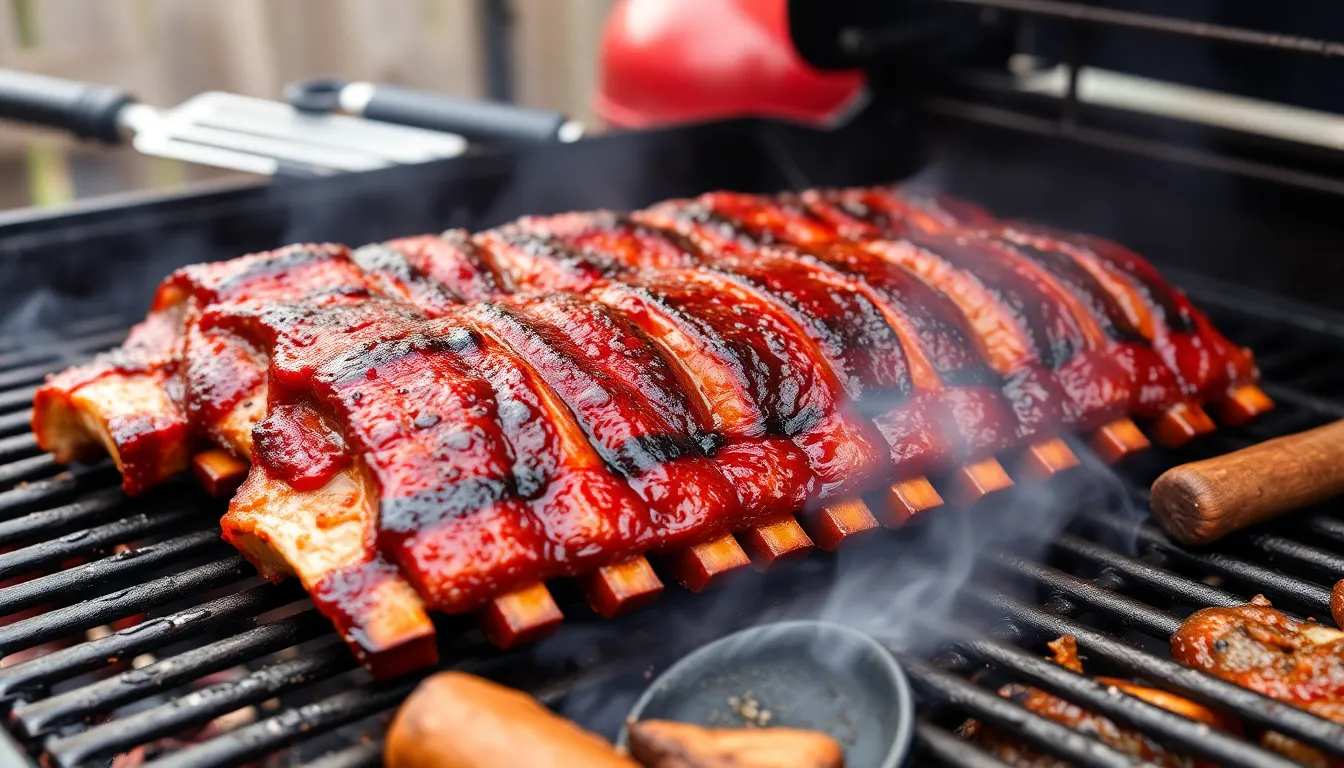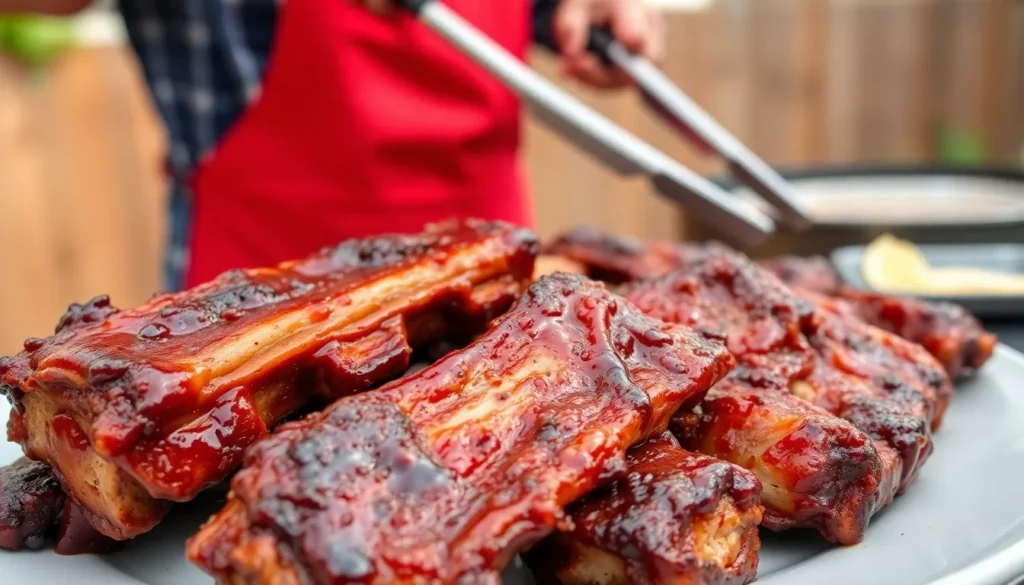Table of Contents
ToggleWhen it comes to spare ribs, the debate rages on: are they beef or pork? It’s the culinary equivalent of asking if a hot dog is a sandwich. While some might argue that ribs are just ribs, the truth is a bit more nuanced and delicious. Understanding the difference can elevate your BBQ game and impress your friends at the next cookout.
Understanding Spare Ribs
Spare ribs are a popular cut of meat characterized by their rich flavor and tenderness. They primarily come from pigs, specifically the lower section of the ribcage.
Definition of Spare Ribs
Spare ribs consist of the rib bones and surrounding meat, situated beneath the backbone of the pig. They contain more fat than other rib cuts, contributing to their unique flavor and juiciness. Often, they include a layer of connective tissue, which tenderizes when cooked low and slow. Grilling or smoking spare ribs enhances their natural taste, making them a favorite for barbecue enthusiasts.
Types of Spare Ribs
Several types of spare ribs exist, each offering distinct characteristics. Regular spare ribs feature a larger section of bone, often yielding a meatier portion, while St. Louis-style ribs are trimmed into a more rectangular shape, removing the sternum and cartilage. Both types are ideal for grilling, but St. Louis ribs may cook more evenly due to their shape.
Choosing the right type depends on personal preference and cooking methods. Each type performs well with various rubs and sauces, elevating the barbecue experience.
Are Spare Ribs Beef or Pork?

Spare ribs primarily come from pigs, making them a pork cut that many enjoy for their distinctive flavor and texture.
Characteristics of Pork Spare Ribs
Pork spare ribs originate from the lower section of a pig’s ribcage. They feature both bone and a generous amount of meat, resulting in rich flavor and tenderness. This cut contains more fat than other types of ribs, contributing to juiciness when cooked. The natural marbling enhances taste during grilling or smoking. Regular spare ribs and St. Louis-style ribs fall under pork variety, with the latter being trimmed for a more uniform shape. Each type responds differently to marinades and cooking methods, allowing for variety in preparation.
Characteristics of Beef Spare Ribs
Beef spare ribs come from the brisket area or lower rib section of cattle. This cut typically has thicker meat and more pronounced beefy flavor. They consist of flatter bones with meat surrounding them, making them ideal for slow-cooking or barbecuing. Beef spare ribs retain less fat than pork spare ribs but deliver a different richness. Ideal cooking methods include braising or smoking, allowing flavors to develop over several hours. Unlike their pork counterparts, beef ribs often complement robust spice blends and sauces, enhancing their savory profile at any barbecue event.
Popular Preparation Methods
Spare ribs shine through various cooking techniques, each bringing out unique flavors. Grilling and smoking top the list for enthusiasts seeking delicious results.
Grilling Spare Ribs
Grilling spare ribs yields a smoky char that enhances their rich flavor. Heats strong enough to create a sear help seal in juices, making the meat tender. Using a dry rub with spices like paprika, garlic powder, and brown sugar complements the natural taste. It’s common to grill spare ribs on medium heat for about two hours, turning frequently. Basting with barbecue sauce during the last 30 minutes infuses flavor while forming a delicious glaze.
Smoking Spare Ribs
Smoking spare ribs imparts a deep, enriching flavor that many barbecue aficionados prefer. The low and slow method allows fats to render, resulting in juicy meat. Using wood chips, such as hickory or apple, adds distinctive notes to the aroma and taste. It’s ideal to smoke spare ribs at 225°F for about four to six hours. Wrapping ribs in foil halfway through the process retains moisture, leading to perfectly tender meat.
Nutritional Comparisons
Understanding the nutritional profiles of pork and beef spare ribs allows for informed dietary choices.
Nutritional Value of Pork Spare Ribs
Pork spare ribs offer a rich flavor alongside a decent amount of fat. A typical serving size of 3 ounces contains approximately 300 calories, 20 grams of fat, and 25 grams of protein. They also supply vital nutrients, including iron and zinc, which support overall health. High-fat content contributes to their juiciness, making them enjoyable for many. While they provide energy, moderation is key due to cholesterol levels, which can reach about 90 milligrams per serving.
Nutritional Value of Beef Spare Ribs
Beef spare ribs present a different nutritional landscape. A 3-ounce serving typically contains about 350 calories, 27 grams of fat, and 24 grams of protein. They also offer essential vitamins and minerals like vitamin B12 and niacin, important for maintaining energy levels and overall well-being. Compared to pork ribs, beef ribs often contain slightly less fat but deliver a robust flavor. Considering their nutritional attributes, they pair well with lighter dishes to balance meals effectively.
Spare ribs are a delicious and versatile choice for barbecue enthusiasts. With their rich flavor and tender texture they stand out whether sourced from pork or beef. Pork spare ribs dominate the scene thanks to their higher fat content which enhances juiciness and flavor. On the other hand beef spare ribs offer a heartier taste that appeals to those who prefer a more robust profile.
Understanding the differences between these two types of ribs allows for better cooking techniques and flavor pairings. Whether grilling or smoking the right preparation can elevate any barbecue experience. By exploring these cuts and their unique characteristics anyone can impress guests and enjoy a memorable meal.







